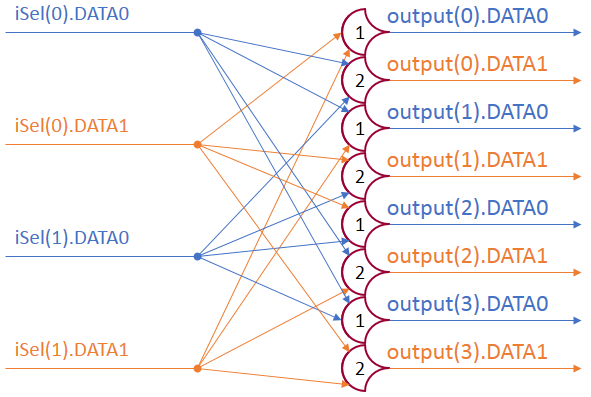Design Recap
The circuit diagram of the decoder:

This decoder will be generic, and be implemented much like the MUX.
Implementation
Each row will be generated based on it’s index. For each input:
- If it is set:
- Use DATA0 for the DATA0 of that case’s output
- Use DATA1 for the DATA1 of that case’s output
- If it is clear:
- Use DATA1 for the DATA0 of that case’s output
- Use DATA0 for the DATA1 of that case’s output
The DATA0 output sets are combined with a THN1, and the DATA1 outputs are combined with a THNN:
Rows: for i in 0 to NumOutputs - 1 generate
cntlBits: for iBit in 0 to NumInputs - 1 generate
Cntl0Selection: if (to_signed(2**iBit, NumInputs+1) and to_signed(i, NumInputs+1)) = 0 generate
Gate0Inputs(i)(iBit) <= inputs(iBit).DATA1;
Gate1Inputs(i)(iBit) <= inputs(iBit).DATA0;
end generate;
Cntl1Selection: if (to_signed(2**iBit, NumInputs+1) and to_signed(i, NumInputs+1)) > 0 generate
Gate0Inputs(i)(iBit) <= inputs(iBit).DATA0;
Gate1Inputs(i)(iBit) <= inputs(iBit).DATA1;
end generate;
end generate;
Gate0: THmn
generic map(N => NumInputs, M => 1)
port map(inputs => Gate0Inputs(i),
output => outputs(i).DATA0);
Gate1: THmn
generic map(N => NumInputs, M => NumInputs)
port map(inputs => Gate1Inputs(i),
output => outputs(i).DATA1);
end generate;
This assigns input cases to the gates. If any non-selected values are asserted, then the DATA0 line of that case is asserted.
Adding the declarations around it:
library ieee;
use ieee.std_logic_1164.all;
use work.ncl.all;
use ieee.numeric_std.all;
entity Decoder is
generic(NumInputs : integer := 2);
port(inputs : in ncl_pair_vector(0 to NumInputs-1);
outputs : out ncl_pair_vector(0 to (2**NumInputs)-1));
end entity Decoder;
architecture structural of Decoder is
constant NumOutputs : integer := 2 ** NumInputs;
type GateInputs is array (integer range <>) of std_logic_vector(0 to NumInputs - 1);
signal Gate0Inputs : GateInputs(0 to NumOutputs-1);
signal Gate1Inputs : GateInputs(0 to NumOutputs-1);
begin
Rows: for i in 0 to NumOutputs - 1 generate
cntlBits: for iBit in 0 to NumInputs - 1 generate
Cntl0Selection: if (to_signed(2**iBit, NumInputs+1) and to_signed(i, NumInputs+1)) = 0 generate
Gate0Inputs(i)(iBit) <= inputs(iBit).DATA1;
Gate1Inputs(i)(iBit) <= inputs(iBit).DATA0;
end generate;
Cntl1Selection: if (to_signed(2**iBit, NumInputs+1) and to_signed(i, NumInputs+1)) > 0 generate
Gate0Inputs(i)(iBit) <= inputs(iBit).DATA0;
Gate1Inputs(i)(iBit) <= inputs(iBit).DATA1;
end generate;
end generate;
Gate0: THmn
generic map(N => NumInputs, M => 1)
port map(inputs => Gate0Inputs(i),
output => outputs(i).DATA0);
Gate1: THmn
generic map(N => NumInputs, M => NumInputs)
port map(inputs => Gate1Inputs(i),
output => outputs(i).DATA1);
end generate;
end structural;
Testing
I tested it for 2 inputs, to make sure the generics build correctly. The outputs do not go through all combinations, since only one is allowed to be DATA1 at a time. Here’s the test script

Commit: a58ee22

